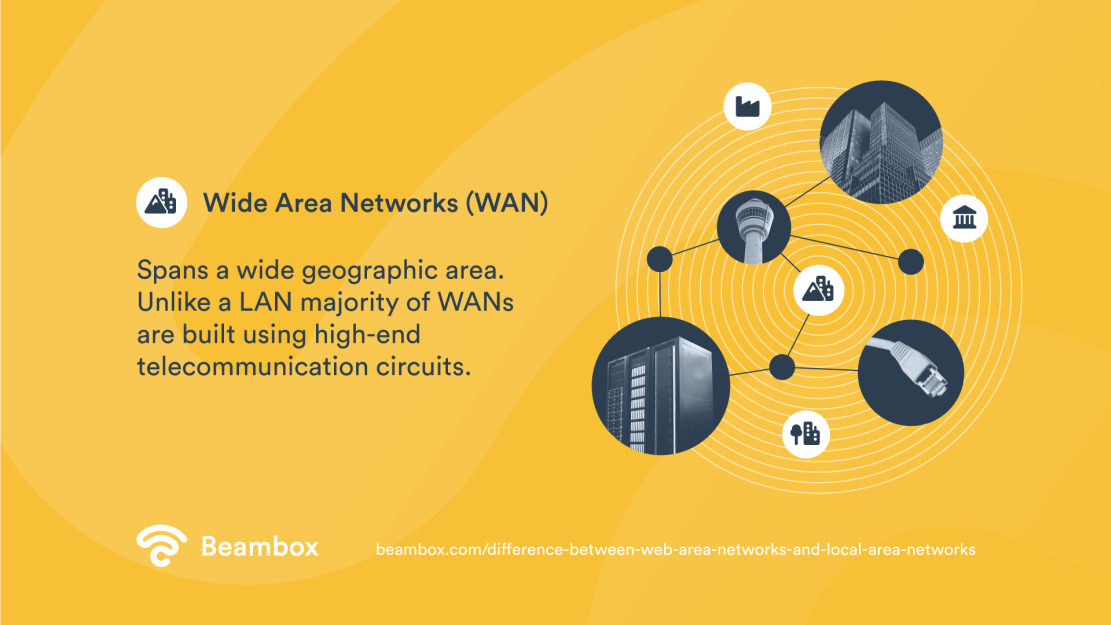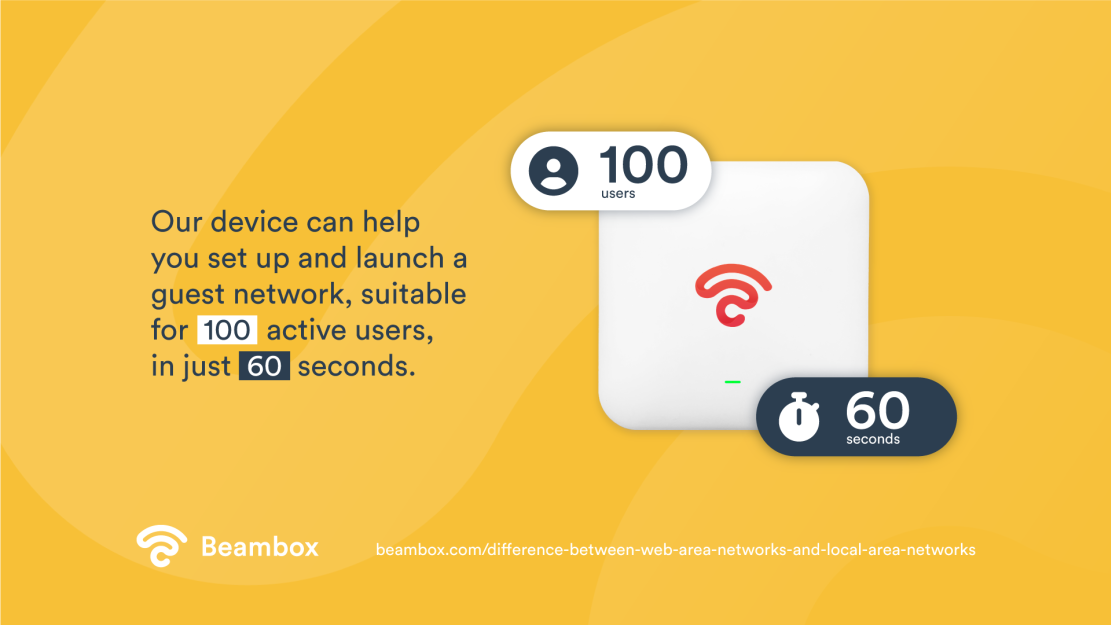The history of Wi-Fi dates back to the 1970s. Today, the internet is a vital and unavoidable part of most people’s lives. In 2020, an ONS survey found that over 92% of adults had used the internet recently. Most people actively seek out WiFi hotspots, because don’t you want to learn how to get free WiFi anywhere you go?
As a business, understanding basic information about internet connections and network traffic can help you use them to your benefit. For instance, you’ll have likely come across the terms LAN and WAN if you use digital marketing or provide WIFI at your establishment. Understanding the difference between a LAN and WAN computer network can save you time and money when connecting to a computer and peripheral devices.

You may have seen the terms LAN and WAN on your router’s ports. This is because the router connects your network devices to your modem and allows you to access the wider internet. You can share a single internet connection with your devices using a router. To connect to a router, you can connect through a wireless access point or a wired connection using an ethernet cable.
Wired connections offer sizeable stability, security, and potentially faster speeds. Wireless connections are convenient for network users that want more devices connected with more mobility, and fewer hardware purchases.
To define a LAN, simply put, a smartphone or computer becomes a part of the Local Area Network (LAN) when it connects to your wireless router. The Wide Area Network (WAN) is everything else outside this direct connection. So, the internet as a whole is the WAN.
For many people, these terms are alien. You likely won’t know exactly what these mean or the difference between them (unless you’re a bit of an IT whizz). We’ll discuss everything you need to know below.
LAN (Local Area Networks)
You may have asked, what does LAN stand for? LAN stands for Local Area Network and refers to devices connected in a limited area (typically between 100 and 1,000 meters). A Local Area Network is handy for sharing resources and files. If you have connected your home or office computer to a printer, you will have done so using the LAN port.

If you are looking for a wireless LAN connection, it is possible to extend the distance by adding more wireless access points (WAP) to the LAN. Businesses like restaurants, colleges, hospitals, or offices frequently use LAN ports for internet access.
Application of Local Area Network
Some of the most common uses of Local Area Networks include:
- It allows devices within a set area (e.g., a building) to talk to each other without an internet connection.
- A computer can be assigned as the server computer to manage other devices in the network.
- All connected devices can access any software kept on a LAN server.
- Share Local Area Networks through resources such as printers or scanners.
WAN (Wide Area Networks)
Now to define Wide Area Network or WAN. A WAN is an extensive computer network. It spans a wide geographic area, unlike a LAN. One of the benefits of Wide Area Networks is that the majority are built using high-end telecommunication circuits. Unlike the LAN, Wide Area Networking equipment is relatively expensive and not usually owned by any one organization. Larger geographical range typically requires leased telecommunication lines. WAN ports use connectivity technologies including ethernet cables and frame relay.

Application of Wide Area Network
The application of WAN networks has many uses. These include:
- Sending and receiving emails.
- Transferring files.
- Remote access to update a central database.
- Reservations for restaurants, railways, and airlines often use this network.
- Sharing data and other resources between a business or educational facility.
For instance, if you are a hospitality business looking to connect with potential customers, you need to use a WAN. WANs can facilitate connections like email marketing campaigns. Check out our hospitality guide to email for more information on how you could do this. Email marketing can boost brand image. If you are wondering how to get more Google reviews, email campaigns are an effective method to encourage engagement.
LAN vs. WAN Computer Network
A WAN is a network covering a wide geographical area. A LAN, on the other hand, is usually a privately owned network run by network administrators that only covers a small space like a home, office, or school. Networks allow for direct digital communications. The internet is a vast network that connects devices worldwide.
When you see WAN or LAN, just know that these refer to computer networks through an internet service provider. A network is essentially a collection of computers and other devices that can connect. For example, several devices found on a network could include smartphones, video gaming consoles, smart TVs, and routers.
Another difference between LAN and WAN is they have different rule systems. They simply exist to connect computers and help them communicate and comprehend one another.
A local area network, or LAN, is a small network. It’s common to find it in a house or company through an enterprise network. Devices on a LAN frequently use the network infrastructure to connect to the internet, although they can often interact more rapidly over the LAN.
For example, when sending a file to a printer in the same LAN, there is usually no reason to do so via the public internet. Instead, the task can be completed quickly using wireless communication, cable connectivity, or both on the LAN. If the thought of connectivity speed prompts you to ask, “What’s the difference between 2.4 GHz and 5 GHz WiFi?” — the difference is in terms of coverage and the broadband speed each one supports.
What are examples of Wide Area Networks? WAN often connects many geographical locations. For example, you would need a WAN to connect to far-flung offices and data centers inside specific large organizations. The very best-known example of a WAN is the internet. A MAN, or Metropolitan Area Network is restricted to a geographical location that can reach several buildings within a particular city or town. A WAN stands, in comparison, not restricted to a particular area.
The Difference Between LAN and WAN: Direct Comparisons
Speed
LAN networks usually offer a high data transfer rate. It has higher speeds of around 1,000 Mbps.
WAN network speeds are generally slower than LANs and are approximately 150 Mbps.
Congestion
LANs have fewer connected devices and very little congestion.
WANs connect many devices and are more congested than smaller networks.
Bandwidth Possibilities
LANs have high bandwidths available for transmissions.
WANs bandwidths for transmissions are lower.
Data Transfer
LAN has a higher data transfer rate for data packets.
WAN has a lower data transfer rate.
Connection
LAN covers long distances through radio waves and telephone lines.
WAN devices can connect through public networks like telephone systems, satellites, or leased lines.
Faults
There are fewer faults in LANs because it is dealing with fewer systems. LANs have more fault tolerance.
The large number of systems involved in WANs gives them less fault tolerance.
Costs of LAN vs WAN
LAN costs are usually low since setups involve few devices, and network maintenance is often fairly straightforward.
You can set up WANs using public networks relatively cheaply when using software, whereas private networks and connecting to remote areas are considerably more expensive.
Maintenance of WANs and WAN optimization is more complicated and costly because of the wide geographical location they cover.
Advantages of LAN and WAN
If you want to provide your customers with WIFI access, you will need to understand the difference between LAN and WAN connections and utilize both.
When you connect wireless routers with a device, like a computer or smart phone, it becomes part of the LAN. Everything outside of this is the WAN. LAN allows easy sharing, so you can use the same software on more devices connected to a computer. If you are interested in picking exemplary WiFi service for your restaurant, hotel, or cafe, these are the first steps into taking advantage of both LAN and WAN to enhance your guest experience. Learn about more ways you can impact your customer experience, including what is a captive portal and why sending your guests an email before their birthday is a must-do marketing campaign strategy.
One of the easiest ways to ensure your business has safe, secure, and easy-to-use WIFI is with Beambox. Beambox builds brand awareness through Wi-Fi marketing. Our device can help you set up and launch a guest network (suitable for 100 active users) in just 60 seconds. Visit Beambox to learn more about our plug-and-play installations.

Get Started With Free WiFi Marketing
Beambox helps businesses like yours grow with data capture, marketing automation and reputation management.
Sign up for 30 days free